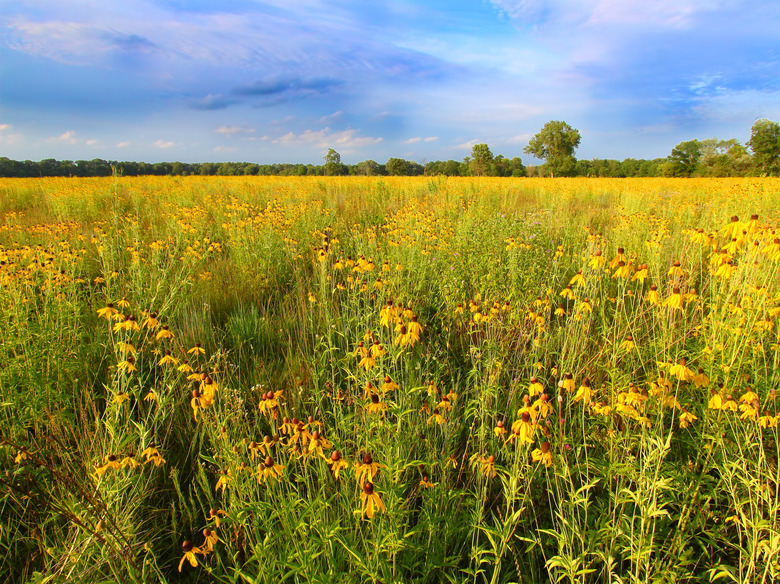Climate In Temperate Grasslands
Grassland ecosystems are land areas dominated by grasses that have very few or no woody shrubs or trees. Temperate grasslands are characterized by their lack of trees and extreme temperature ranges between summer and winter. Despite their lack of trees, grasslands are some of the richest ecosystems in the world in terms of biodiversity. Temperate grasslands can be found all over the world, from the steppes of the former Soviet Union to the pampas of Argentina and Uruguay.
Two Types of Temperate Grasslands
Two Types of Temperate Grasslands
Temperate grasslands are large areas of land that are dominated by a variety of species of grasses. Temperate grasslands have cold winters and hot summers – sometimes with temperature swings of over 140 degrees Fahrenheit between winter lows and summer highs. Fast-moving weather systems tend to affect the temperate grasslands, and they are also susceptible to drought and dust storms. Temperate grassland average rainfall varies within the ecosystem.
There are two main categories of temperate grasslands: prairies and steppes. A prairie is a grassland that is dominated by tall grasses; a steppe is a grassland dominated by shorter grasses. Grass height is directly related to amount of precipitation: areas with more rainfall have taller grasses than drier areas. A mixed prairie has a combination of tall and short grasses.
In prairie ecosystems, the average rainfall per year is usually between 20 and 35 inches (50.8-88.9 cm) and average temperatures range between minus 40 degrees Fahrenheit (minus 40 degrees Celsius) in winter and 100 degrees Fahrenheit (38 degrees Celsius) in summer.
The climate of a steppe grassland reflects similar average temperatures of the prairie, with hot summers and cold winters. Steppe precipitation is less than that of the prairie ecosystem, with average rainfall falling somewhere between ten and 20 inches of rain per year (25.4-50.8 cm). Steppe grassland ecosystems can be found in the interior of North America and Europe.
Temperate Grassland Biodiversity
Temperate Grassland Biodiversity
The temperate grasslands boast some of the highest species diversity in the world. For example, in the North American tallgrass prairies, up to 80% of the living foliage is made up of grasses, with 40 to 50 different species of grasses coexisting together in one place. The remaining 20% of vegetation is composed of over 300 forbs (a forb is a type of small plant) and other flowering plants, and over 100 species of lichens and liverworts.
Grass species include purple needlegrass, blue grama, buffalo grass, galleta and speargrass. Sagebrush, cacti and flowers such as asters, wild indigos, sunflowers and coneflowers also thrive. While there are typically no trees in the temperate grasslands, the occasional river valley may host a few species of trees, such as cottonwood, oak and willow trees.
Many grassland animals make the North American prairies home, including the recovering American bison, elk, deer, antelope, foxes, coyotes, ground squirrels, snakes, rabbits and prairie dogs. Birds that live on the prairie include quail, sparrows, hawks, grouse, blackbirds, owls and meadowlarks. Leafhoppers, spiders and a variety of other invertebrates also live on the prairie.
Grass Roots
Grass Roots
The deep, dark, nutrient-rich soil of the temperate grasslands is held together by decaying grass roots. This mat of roots provides structure for the grassland ecosystem by preventing erosion of soils, and also provides food for the living plants, fungi, invertebrates and other organisms that live there. Bricks cut from the mat of roots and soil, called sod, were once a popular material for building houses on the prairie.
Living grasses protect themselves from the extreme temperatures on the prairie by having up to 80% of their biomass located underground. The mat of rhizomes can stretch 15 feet below the surface of the ground, anchoring the grasses and working together with micorrhizal fungi to provide nutrients for the aboveground portion of the plants.
Microclimates and Niches
Microclimates and Niches
Biological communities within a prairie ecosystem vary widely due to environmental conditions such as local temperature, soil type, depth of fertile soil, rainfall and soil moisture content, and slope of the terrain. Temperate grassland communities also rely on cycles of seasonal drought and wildfires; these cycles are important for biodiversity and prevent woody plants such as trees and shrubs from taking over the grassland. Grazing by large mammals also keeps woody plants from becoming established.
Several different, distinct types of microclimates can exist within a larger prairie ecosystem, including wet seeps, bottomlands and wind-blown hilltops. Each different grassland climate will effect the types of grasses and associated species that live there. Each type of grass, wildflower and animal occupies a specific niche in the larger prairie ecosystem.
Destruction of the Temperate Grasslands
Destruction of the Temperate Grasslands
The tallgrass prairies of North America used to cover over 170 million acres, comprising the continent's largest contiguous ecosystem. Currently, less than 1% of the original prairie still exists. Most of the prairie today is used for crop production and land for grazing cattle.
Agricultural practices, as well as human development in general, have had negative effects on prairie ecosystems and reduced them to a small fraction of what they once were. The conditions on the prairie such as nutrient-rich soil and the flat, treeless terrain made it perfect for cropland. Plowing land for crops such as wheat releases loose soil, especially in a drought, and can cause dust storms. Other human activities such as cattle overgrazing and agricultural runoff from irrigation have contributed to the destruction of natural prairie ecosystems.
Cite This Article
MLA
Reinbold, Joan. "Climate In Temperate Grasslands" sciencing.com, https://www.sciencing.com/climate-temperate-grasslands-8038155/. 30 September 2021.
APA
Reinbold, Joan. (2021, September 30). Climate In Temperate Grasslands. sciencing.com. Retrieved from https://www.sciencing.com/climate-temperate-grasslands-8038155/
Chicago
Reinbold, Joan. Climate In Temperate Grasslands last modified March 24, 2022. https://www.sciencing.com/climate-temperate-grasslands-8038155/
